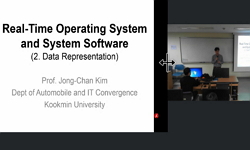This paper is a study on the composition of Real-Time Continuous Speech Recognition System for Man-Machine Interface and it examines the posibility that applies to automatic system. HMM model can be classified into Continuous Distribution HMM and Dis...
http://chineseinput.net/에서 pinyin(병음)방식으로 중국어를 변환할 수 있습니다.
변환된 중국어를 복사하여 사용하시면 됩니다.
- 中文 을 입력하시려면 zhongwen을 입력하시고 space를누르시면됩니다.
- 北京 을 입력하시려면 beijing을 입력하시고 space를 누르시면 됩니다.
https://www.riss.kr/link?id=T3970014
- 저자
-
발행사항
부산: 동아대학교, 1996
- 학위논문사항
-
발행연도
1996
-
작성언어
한국어
- 주제어
-
DDC
621.3
-
발행국(도시)
대한민국
-
형태사항
100 p.: 삽도; 27 cm
- 소장기관
-
0
상세조회 -
0
다운로드
부가정보
다국어 초록 (Multilingual Abstract)
This paper is a study on the composition of Real-Time Continuous Speech Recognition System for Man-Machine Interface and it examines the posibility that applies to automatic system.
HMM model can be classified into Continuous Distribution HMM and Discrete Duration Control HMM, and the recognition algorithm can be classified into O(n)DP method and One Pass DP method in order to choose HMM model and recognition algorithm.
The simulation is implemented for 35 continuous speech samples of four connected spoken digits in two cases which are divided into two submodels according to whether the regression coefficients are included or not. As a result of the simulation, the average recognition rates show 93.0% and 80.5% respectively for two cases; the one is Continuous Distribution HMM model which includes regression coefficients and the other does not include when O(n)DP method is used.
Average recognition rates show 93.4% and 84.4% respectively for two cases the one is Discrete Duration Control HMM model which includes regression coefficients and the other does not include when O(n)DP method is used.
When HMM model does not include regression coefficients, the average recognition rate of One Pass DP method is better improved than that of O(n)DP method by 12%.
The Continuous Speech Recognition System is composed of Continuous Distribution HMM model and algorithm of One Pass DP method which are chosen by the consideration of computing time and recognition rate according to the result of simulation.
Continuous Speech Recognition System is composed so that it may detect start point and end point of speech data which are converted into samples by 10 KHz, 8 bit A/D within real time, then so that it may recognize them by One Pass DP method, display the result of recognition on PC monitor and at same time send control data to Interface.
HMM models are created by training for continuous speech samples which are control words, area names and digital sounds.
In the result of experiment by Continuous Speech Recognition System, there are some kind of errors which are insertion, replacement and deletion of one syllable, but it examined the posibility that can be applied to Man-Machine Interface on automatic system if post-process is performed for recognition.
목차 (Table of Contents)
- 목차 = ⅰ
- Ⅰ. 서론 = 1
- Ⅱ. 음성분석 = 6
- 1. 음성분석 = 6
- 가. 선형예측계수 분석 = 8
- 목차 = ⅰ
- Ⅰ. 서론 = 1
- Ⅱ. 음성분석 = 6
- 1. 음성분석 = 6
- 가. 선형예측계수 분석 = 8
- 나. 켑스트럼 분석 = 12
- 2. 음성의 지각 = 17
- Ⅲ. HMM 모델링 = 19
- 1. 마코프과정 (Markov Process) = 19
- 2. 기본 HMM = 22
- 3. 이산출력 확률분포 HMM = 34
- 4. 연속출력 확률분포 HMM = 36
- 5. 지속시간제어 HMM = 38
- 6. 동적특징 파라메터를 이용한 HMM = 41
- 7. 혼합연속출력 확률분포 HMM = 42
- Ⅳ. 연속음성인식 알고리듬 = 46
- 1. O(n)DP법에 의한 연속음성 인식 = 51
- 2. One Pass DP법에 의한 연속음성 인식 = 54
- Ⅴ. 시뮬레이션에 의한 음성인식 = 59
- 1. 시뮬레이션 시스템 구성 = 59
- 2. 시뮬레이션 방법 = 61
- 3. 시뮬레이션 결과 및 고찰 = 64
- Ⅵ. 실시간 연속음성인식 시스템 구현 = 69
- 1. 시스템 구성 개요 = 69
- 2. 실시간 시작점·끝점 검출 방법 = 71
- 3. 참조패턴 학습 시스템 구성 방법 = 75
- Ⅶ. 실시간 음성인식 실험 및 고찰 = 77
- 1. 음성자료 및 분석조건 = 77
- 2. 학습 및 인식 방법 = 78
- 3. 결과 및 고찰 = 83
- Ⅷ. 결론 = 90
- 참고문헌 = 93
- SUMMARY = 99












